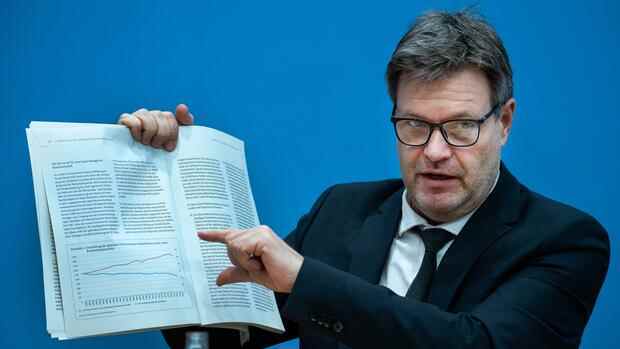Berlin What added value would a pyramid have in Germany? Apart from tourists, who would certainly look at a building that is so unusual for this country and would travel to Germany, probably not too big.
Nevertheless, the pyramid would be included in the statistics as an increase in prosperity. After all, it takes bricks to build and the strength of workers who want to be paid – both of which add value that would be reflected in gross domestic product (GDP).
And how the GDP thrives and grows over the years, politicians and economists understand over the years as the measure of prosperity. But in Berlin there is now a Federal Minister of Economics who is breaking with this tradition. Robert Habeck (Greens) no longer sees prosperity simply as economic growth.
And so the minister gave the annual economic report, the annual commemorative publication on the economic policy of every federal government, so to speak, a completely new coat of paint – with a chapter that has never existed in the more than 50 years of the report.
Top jobs of the day
Find the best jobs now and
be notified by email.
In it, Habeck’s officials list 31 alternative indicators for measuring prosperity. This ranges from the proportion of women in managerial positions to the nitrate content in groundwater and the permeability of the education system to overburdening with housing costs.
Criticism of measuring wealth, not growth
Why is that needed when GDP has been the measure of all things for decades? At the presentation of the annual economic report on Wednesday, Habeck explained why, in his view, equating GDP alone with prosperity did not go together.
Everything would initially enter GDP neutrally, regardless of whether it was good or bad for prosperity. In other words: According to this view, higher GDP can also result from worse things, according to Habeck’s understanding. “In the end, the economy also grows when we build pyramids,” said Habeck.
One of the new indicators of prosperity is the development of greenhouse gas emissions. The Ministry of Economics aptly depicted this in a graphic together with the GDP in the current report.
Page 14 of the Annual Economic Report, which Habeck demonstratively raised when presenting it, is a good example of the function that the new indicators are to assume in the future. “You can see how far apart that goes,” said the still-Green boss. Growth must be achieved with fewer emissions.
“It’s about combining growth and CO2 savings.”
(Photo: Reuters)
Habeck doesn’t want to ignore GDP. A criticism of growth à la Club of Rome from the time in the opposition in the federal government, as it was echoed by the ranks of leading Greens and sometimes by Habeck, has given way to pragmatism.
“To say we’re giving up the idea of growth would mean we’re giving up the idea of progress,” Habeck said. Rather, the new key figures should help to interpret the GDP in a more targeted manner.
Economy is open-minded, but sees room for improvement
The minister left it open how this is supposed to work in practice. It is clear, however, that the special chapter is not an accessory or adornment: “This is not about academic dry swimming.” It is possible that the figures would appear in the federal government’s semi-annual economic forecasts in addition to the annual economic report.
However, that is considered unlikely as there would be too little movement due to the delay in much of the data. The time series of the Gini coefficient as a measure of inequality in income or expenditure on educational institutions currently only extends to around 2019.
In addition, the annual economic report should only be the beginning of the debate as to which indicators are needed to measure sustainability. Stefan Körzell, member of the board of directors of the German Federation of Trade Unions, has already announced that there is a need for expansion. “The newly introduced prosperity indicators should definitely be supplemented with criteria for good work, such as collective agreements,” Körzell told the Handelsblatt.
Industry President Siegfried Russwurm commented: “The measurement of prosperity can definitely go beyond simply recording real economic output.” However, the ambitious environmental and climate policy of the new federal government must not endanger entrepreneurial activities.
The opposition was more critical. “Our country doesn’t need a philosopher now to think about the limits of growth,” said Gitta Connemann, chairwoman of the Mittelstands- und Wirtschaftsunion (MIT). In any case, Habeck’s visions go beyond government work. He spoke of possible transparency criteria for the financial markets or funding conditions in public procurement.
Assistance: Frank Specht
More: How Habeck and Lindner struggle for the annual economic report
